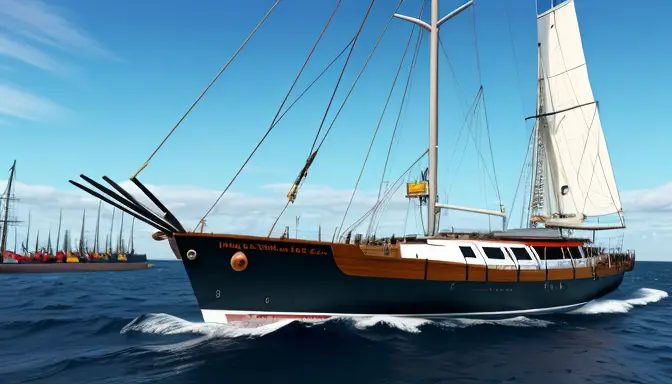Converting a sailboat into a trawler is an exciting journey that requires careful planning and execution. From assessing the initial condition of the sailboat to conducting sea trials, each step plays a crucial role in the successful transformation process. Let’s dive into the step-by-step conversion guide to understand the necessary modifications, equipment upgrades, and considerations for turning a sailboat into a trawler:
- Initial Assessment and Planning: Start by evaluating the current state of the sailboat, create a detailed conversion plan, and set a budget to ensure a smooth transition.
- Hull and Structure Modifications: Discuss the required hull reinforcement, structural changes, and alterations needed to adapt to the trawler’s design and functionality.
- Engine and Propulsion System Upgrade: Explore the installation of a new engine, propulsion system, and adjustments to fuel capacity for improved performance.
- Electrical and Navigation Systems: Upgrade electrical components, install navigation equipment, and integrate modern technology for safe trawler operations.
- Interior Renovations and Comfort Features: Transform the interior layout, add amenities, and optimize living spaces for comfort during long journeys.
- Safety Measures and Compliance: Address safety concerns, meet regulatory requirements, and implement emergency protocols for a secure conversion.
- Sea Trials and Final Adjustments: Conduct trials, fine-tune performance, and make final adjustments to ensure a successful transition to a trawler.
Initial Assessment and Planning
When embarking on the exciting journey of converting a sailboat into a trawler, the initial assessment and planning phase play a crucial role in setting the foundation for a successful transformation. To kickstart the process, it is essential to conduct a thorough evaluation of the sailboat’s current condition. This assessment involves inspecting the hull, structural integrity, engine performance, and overall functionality to identify areas that require modification or upgrade.
Creating a comprehensive conversion plan is the next step in the process. This plan should outline the specific modifications and enhancements needed to transition the sailboat into a trawler effectively. Consider factors such as the desired trawler design, equipment requirements, and timeline for completion. Setting a realistic budget is also vital to ensure that the project stays on track financially.
During the planning phase, it is beneficial to consult with experts in boat conversion or marine engineering to gain valuable insights and guidance. Their expertise can help streamline the process and avoid potential pitfalls along the way. By carefully assessing the sailboat’s condition, creating a detailed conversion plan, and setting a budget, you can lay a solid groundwork for a successful sailboat to trawler transformation.

Hull and Structure Modifications
When it comes to converting a sailboat into a trawler, play a crucial role in the transformation process. These modifications are essential to ensure the vessel’s seaworthiness and functionality as a trawler. Here are some key considerations for hull and structure modifications:
- Hull Reinforcement: Strengthening the hull to withstand the demands of trawler operations, including potential impacts and increased weight.
- Structural Changes: Adapting the boat’s structure to accommodate the new layout and equipment required for trawler functionality.
- Alterations for Design and Functionality: Making necessary changes to the hull and structure to align with the specific requirements of a trawler, such as adding storage space or modifying the deck layout.
By addressing these aspects of with precision and expertise, the conversion from a sailboat to a trawler can be executed seamlessly, ensuring a successful and efficient transition.
Engine and Propulsion System Upgrade
When it comes to upgrading the engine and propulsion system of a sailboat to transform it into a trawler, meticulous planning and execution are key. The engine is the heart of the vessel, providing the power needed for smooth sailing and efficient operation. Here are some essential steps to consider for a successful engine and propulsion system upgrade:
- Assessment: Evaluate the current engine’s condition and performance to determine the necessary upgrades.
- Research: Explore different engine options suitable for trawler conversions, considering factors like power, fuel efficiency, and compatibility with the vessel.
- Installation: Hire experienced professionals to install the new engine and propulsion system, ensuring proper alignment and functionality.
- Testing: Conduct thorough testing to check the engine’s performance, fuel consumption, and overall reliability before setting sail.
- Adjustments: Make any necessary adjustments to optimize the engine’s performance and ensure smooth operation during voyages.
When it comes to converting a sailboat into a trawler, upgrading the electrical and navigation systems is a crucial step in ensuring a safe and efficient transformation. The electrical system plays a vital role in powering various components onboard, while navigation systems are essential for guiding the trawler on its journeys. Here are some key considerations and upgrades to focus on:
- Electrical System Upgrade: Start by assessing the current electrical setup and determining if it can support the new requirements of a trawler. Consider installing a robust battery bank, solar panels for renewable energy, and efficient wiring to power appliances and electronics.
- Navigation Equipment Installation: Invest in modern navigation tools such as GPS systems, radar, depth sounders, and AIS (Automatic Identification System) for enhanced safety and precision while navigating waters. These systems provide real-time data and alerts to help you navigate effectively.
- Integration of Technology: Embrace smart technology by incorporating touchscreen displays, digital charts, and autopilot systems to streamline navigation processes and improve overall efficiency. Advanced technology can make navigation easier and more intuitive.
- Emergency Systems: Install emergency communication devices like EPIRB (Emergency Position Indicating Radio Beacon) and ensure proper integration with the electrical system for seamless functionality during critical situations. Safety should always be a top priority.
Interior Renovations and Comfort Features
When it comes to transforming a sailboat into a trawler, interior renovations and comfort features play a crucial role in enhancing the overall experience on board. From optimizing living spaces to adding amenities, these modifications can make extended trawler journeys more enjoyable and convenient.
To achieve a comfortable and functional interior, consider the following upgrades:
- Cabin Layout: Reconfigure the cabin layout to maximize space utilization and create separate areas for sleeping, dining, and relaxation.
- Storage Solutions: Install storage compartments, shelves, and drawers to keep belongings organized and easily accessible during voyages.
- Galley Enhancements: Upgrade the galley with modern appliances, countertops, and storage to facilitate meal preparation and cooking onboard.
- Comfort Features: Add comfortable seating, bedding, lighting, and climate control systems to ensure a cozy and inviting atmosphere.
- Entertainment Systems: Install entertainment systems such as audio speakers, TV screens, and internet connectivity for leisure activities while at sea.

Safety Measures and Compliance
When it comes to converting a sailboat into a trawler, ensuring safety measures and compliance is paramount. Here are some key steps to consider:
- Inspection: Conduct a thorough inspection of the vessel to identify any safety hazards or areas that need to be brought up to compliance standards.
- Emergency Equipment: Equip the trawler with essential safety gear such as life jackets, fire extinguishers, distress signals, and first aid kits to handle emergencies effectively.
- Regulatory Compliance: Familiarize yourself with maritime regulations and ensure that the trawler meets all necessary requirements for safe operation.
- Navigation Lights: Install proper navigation lights to ensure visibility and compliance with maritime navigation rules, especially during night voyages.
- Training and Certification: Obtain the required training and certifications for operating a trawler, including safety procedures and emergency protocols.
Sea Trials and Final Adjustments
Embarking on the final phase of the sailboat to trawler conversion journey involves the crucial step of sea trials and making necessary final adjustments. This phase is where all the hard work and meticulous planning come together to test the trawler’s performance and functionality in real-world conditions.
During sea trials, the trawler is put through rigorous testing to evaluate its handling, speed, stability, and overall seaworthiness. This process allows for any potential issues to be identified and addressed before the trawler sets sail for its maiden voyage.
Key aspects that are assessed during sea trials include the trawler’s maneuverability in different sea conditions, responsiveness to steering, engine performance, fuel efficiency, and overall comfort of the vessel for extended journeys.
Final adjustments are made based on the observations and feedback gathered during sea trials. This may involve fine-tuning the engine settings, adjusting navigation equipment, optimizing the electrical systems, and ensuring that all safety measures are in place and functioning effectively.
Ultimately, the sea trials and final adjustments phase is crucial in ensuring that the sailboat successfully transitions into a fully functional trawler ready to navigate the open seas with confidence and reliability.
Frequently Asked Questions
- Can any sailboat be converted into a trawler?
While many sailboats can undergo a successful conversion to a trawler, it is essential to assess the sailboat’s structural integrity, size, and compatibility with the desired trawler features before proceeding.
- What are the key considerations when planning a sailboat to trawler conversion?
Important factors include budgeting for modifications, selecting the right propulsion system, ensuring safety compliance, and envisioning the desired interior layout and amenities for comfortable long journeys.
- How long does a typical sailboat to trawler conversion project take?
The duration can vary based on the extent of modifications and upgrades needed, but on average, a comprehensive conversion may take several months to a year to complete, factoring in planning, implementation, and testing phases.
- What Happened to Bluewater Yachts? The Inside Story - May 31, 2024
- Upgrade Your Boat’s Water Pump to the Mach 5 - May 30, 2024
- Upgrade Your Boat with the Big Stuff Stuffing Box - May 30, 2024


